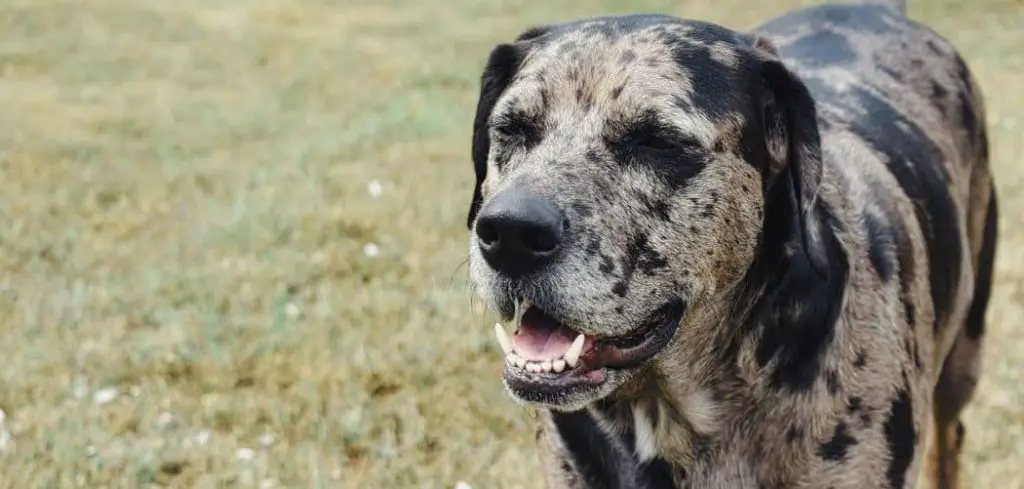If your dog is throwing up green bile and not eating, it’s more than just a one-time stomach upset—it could be a sign of something deeper affecting your dog’s digestive health.
Bile is a digestive fluid that helps break down food, and when it shows up in vomit, especially green or yellow in color, it’s often a warning that the stomach is empty, irritated, or both.
We outline what causes this combination of symptoms, how to determine if it’s serious, and what you can do to support your dog’s health and recovery.
Dog Throwing Up Green Bile and Not Eating: Why It Happens
A dog throwing up green bile and not eating may be suffering from gastrointestinal irritation, empty stomach syndrome, dietary indiscretion, bile reflux, pancreatitis, intestinal blockages, or more serious digestive conditions.
These issues can disrupt normal digestion and make your dog feel nauseated, leading to vomiting bile and refusing food.

Dog Throwing Up Green Bile and Not Eating: Common Causes
1. Empty Stomach Syndrome (Bilious Vomiting Syndrome)
When a dog goes too long without food, bile can build up in the stomach, causing irritation. This condition—known as bilious vomiting syndrome—commonly causes green or yellow bile to be vomited, especially in the early morning.
Symptoms include:
Vomiting green/yellow fluid on an empty stomach
Not eating breakfast or showing reluctance to start eating
Lip licking or swallowing frequently
Acting otherwise normal between vomiting episodes
Feeding your dog smaller, more frequent meals—especially before bed—can help reduce bile buildup and soothe the stomach lining.
2. Dietary Indiscretion
Dogs love to sniff and eat things they shouldn’t—spoiled food, grass, garbage, or non-food items. This “dietary indiscretion” often irritates the stomach, leading to nausea and bile vomiting.
Signs include:
Green bile with bits of grass or unknown materials
Refusal to eat meals after vomiting
Mild or moderate lethargy
Slight gurgling in the belly or burping
Most cases resolve within 24–48 hours with rest and bland food, but frequent or severe vomiting warrants veterinary attention, especially if dehydration is suspected.
Related: Dog vomiting and not eating (Causes and when to worry)
3. Bile Reflux or Gastritis
When bile backs up from the intestine into the stomach, it causes bile reflux gastritis—an inflamed stomach lining due to excess bile exposure. This irritation can lead to:
Recurrent vomiting of bile (especially green or yellow)
Poor appetite or food avoidance
Signs of discomfort (restlessness, lip licking, pacing)
Drooling or signs of nausea without vomiting
This is more common in dogs with irregular eating schedules or those who skip meals frequently. Long-term cases may need medication to control bile production and inflammation.
4. Pancreatitis
Pancreatitis is an inflammation of the pancreas that interferes with digestion and can be very painful.
One of the hallmark signs is vomiting—often of bile—paired with complete disinterest in food.
Look for signs like:
Green/yellow bile vomit
Hunched back or “prayer position”
Tender abdomen or reluctance to move
Weakness, shaking, or whining
Pancreatitis can be triggered by fatty foods, table scraps, or underlying conditions. It requires immediate veterinary care and sometimes hospitalization.
5. Intestinal Blockage or Obstruction
If your dog has eaten a foreign object (toys, bones, socks), it can cause a blockage in the digestive tract. With nowhere for food to go, bile is often the only thing that comes up.
Symptoms include:
Repeated vomiting of green/yellow bile
Refusal to eat or drink
Abdominal bloating or pain
Lethargy and dehydration
Obstructions are serious medical emergencies. If vomiting continues and there’s no bowel movement or gas passed, get to a vet urgently.
6. Liver or Gallbladder Issues
Green bile in vomit can sometimes indicate liver dysfunction or gallbladder problems. These organs help process bile, and when they aren’t working properly, bile may accumulate or leak.
Possible signs include:
Green bile vomit with chronic appetite loss
Yellowing of gums, skin, or eyes (jaundice)
Distended belly or fluid retention
Changes in urination or stool color
Liver-related symptoms require bloodwork and imaging to diagnose. The sooner treatment starts, the better the long-term outcome.
7. Intestinal Parasites
Worms like roundworms or hookworms can inflame the stomach and intestines, causing vomiting—sometimes of bile—and a drop in appetite.
Clues include:
Worms in vomit or stool
Green or foamy bile
Poor weight gain or pot-bellied appearance
Dull coat or excessive itching
A fecal exam and deworming treatment can resolve the issue quickly if parasites are the root cause.
What to Do If Your Dog Is Throwing Up Green Bile and Not Eating
If your dog seems stable (not in pain or dehydrated):
Withhold food for 8–12 hours to let the stomach rest
Offer small amounts of water or ice cubes
Reintroduce a bland diet (boiled chicken and rice) in small portions
Feed smaller, more frequent meals going forward
Avoid fatty foods, treats, or table scraps
If vomiting stops and your dog starts eating within 12–24 hours, it was likely a mild stomach upset. Keep a close eye on stool, energy levels, and hydration.
When to Call or Visit Your Vet
Get veterinary help if your dog:
Vomits bile more than once or twice
Refuses to eat for over 24 hours
Shows signs of pain, bloating, or restlessness
Is lethargic, dehydrated, or trembling
Is a puppy, senior, or has a chronic health issue
Bile vomiting is often treatable, but serious conditions like pancreatitis, blockage, or liver disease must be caught early for the best chance of recovery.
Read more: Dog Constipated and Not Eating (Here’s why)
Key Takeaway
Seeing your dog throw up green bile and refuse to eat is never easy.
Whether it’s mild irritation or something more serious, it’s your dog’s way of saying something isn’t right inside.
Trust your instincts, monitor your dog closely, and don’t hesitate to get professional help if symptoms persist.
Your attention and care make a world of difference—and with the right support, your dog will be back to tail wags and mealtimes before you know it.
